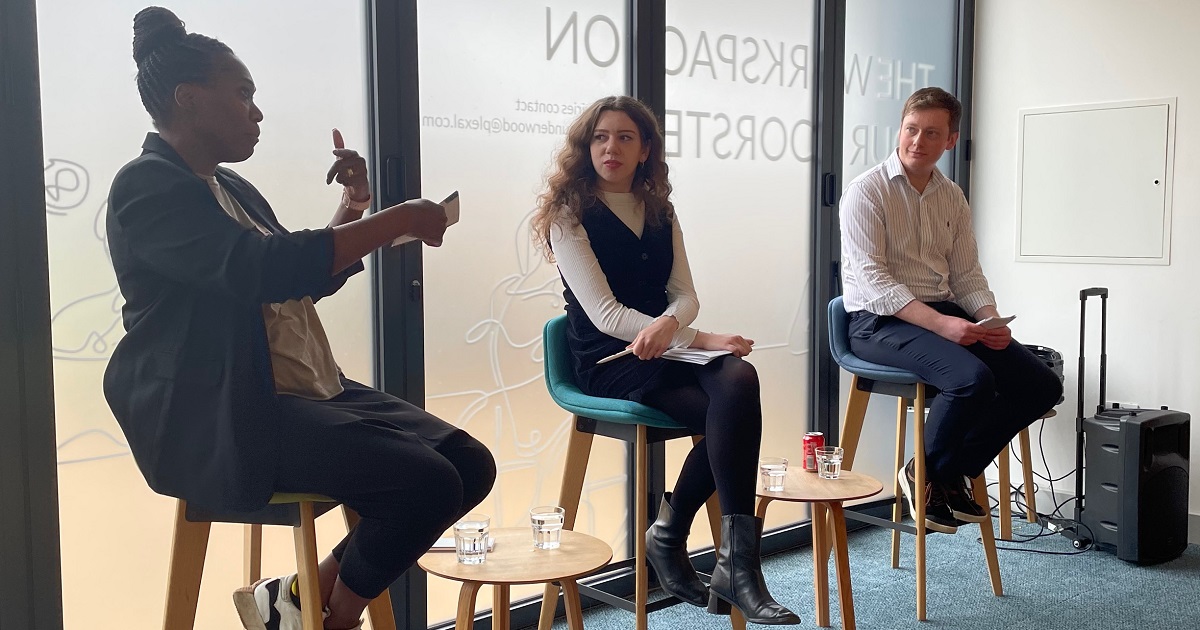On Wednesday 29 March 2023, Plexal Stratford hosted a fireside chat for our workspace members to discuss which areas of tech will see explosive advancement in the near future. The discussion was led by Plexal’s Innovation Associate Matt Miller around two main topics:
- generative AI tools, and the ways startups and SMEs will find to make use of them.
- web 3.0, blockchain as an enabler, and what the next chapter for the internet will look like
We were joined by special guests:
- Laura Foster, Head of Policy for Technology and Innovation at TechUK –The UK’s technology trade association, preparing and empowering the UK for what comes next, delivering a better future for people, society, the economy and the planet.
- Osmin Callis, Managing Director at Block Venture Studio – the innovation partner on Web 3 and blockchain, a consultancy and incubator, de-risking innovation activities and rapidly finding new opportunities, building startups for large corporates who want to access new revenue streams. Sister company to Block Dojo, a workspace member at Plexal who hosted a workshop about International Expansion on Thursday 30 March.
Generative AI
Matt set off the discussion talking about how Generative AI, that uses automation to create original content, has gained traction in recent months largely because of OpenAI, founded by Sam Altman. OpenAI have made advancements in areas such as text-based conversational AI chatbot – ChatGPT, text to image – DALL-E and 3D object generation with Point-E. Other generative AI tools have boomed, naming Synthesia, Midjourney and Stable Diffusion.
Q. What does generative AI mean to your organisation?
Laura explained that generative AI has been around for a long time, and while it’s commonly used to create novel media sources for businesses to supplement their marketing efforts, it also has other use cases that are more exciting for innovation. DeepMind’s AlphaFold for protein folding and drug discovery were cited as examples of exciting new advances for research.
Osmin raised the concern of trust and verification of these technologies, citing the risk of deep fakes. To offset and assure that negative outcomes won’t overtake the positive optics we see today, Osmin suggested supporting activities to thwart such risks.
Q. What are the most exciting developments of AI for you?
The discussion then shifted towards the most exciting developments of AI, including Matt’s favourite use of AI, from a creative aspect, was to create songs in the style of his favourite artist using ChatGPT, then using UberduckAI to synthesise the artists voice to create original music. Laura’s was Charisma AI’s project Electric Sheep which uses AI for dream simulations in VR. Osmin uses AI as a work tool, such as creating headshots and presentations.
The discussion moved onto the question of whether AI will take people’s jobs. Matt noted that these tools should empower rather than replace human workers. He also suggested that generative AI could power the workforce by helping neurodivergent people, such as those with anxiety about writing emails or ADHD who struggle to research multiple webpages. Laura added that generative AI could help with productivity, citing numerous government strategies that indicate SMEs have the most to gain from productivity. Osmin highlighted the importance of speed for her business and offering an alternative to slow-time work by using generative AI to rapidly accelerate market data research, business model proposition validation, and weed out potentially risky startup concepts.
Q. What are the ethical consideration of these technologies?
The conversation also touched on ethical considerations of these technologies, such as the risk of misinformation and disinformation, over what timespan to train language models for, data rights, property rights, and freedom to think.
Laura raised the question of how generative AI gets paid, and whether it is collecting data. Osmin suggested that someone with an interest in our organisations could influence our decision-making processes with potentially negative outcomes on our buying decisions.
The chat ended with a discussion about the future of compute and its importance to AI. Private companies are investing in compute systems into data centers, but this could mean that access to this technology will become increasingly exclusive. This could lead to greater inequality and could hamper innovation in the long run.
Web 3.0
Q: What does web 3.0 mean to your organisation?
The second half of the discussion gave rise to web 3.0 and how the next generation of the internet is going to both look and feel different. Whilst 2021 saw prevalence of the term ‘metaverse’, there are nuances between web 3.0 and the metaverse.
Laura spoke about these differences, highlighting that Web 3.0 is a framework for building a decentralised and user-centric internet, whilst the metaverse, or rather metaverses, is an always-on immersive environment where individuals can interact with one another through a variety of form factors.
Osmin spoke about how the internet is like the ability to turn a landscape into accessible villages, and in the same way blockchains are like different countries with each country having its own legislation and their own currency. The metaverse could offer exponential participation of citizens, machines and other agents interacting in the same environment.
Q: What will be Web 3.0’s impact on innovation and entrepreneurship?
Web 3.0 will provide new business opportunities for entrepreneurs who can create products or services that cater to the next generation of the internet. The decentralised, global nature of web 3.0 enables business growth and expansion through access to a global marketplace. Finally, there are opportunities for entrepreneurs who use disruptive technologies across distributed ledger technologies, AI, Internet of Things, and advanced connectivity to create innovative products and services that leverage web 3.0.
Q: What are the challenges and obstacles of Web 3.0?
Ergonomics of current form factors such as headsets present a challenge to the mass market consumption of web 3.0 applications. Currently, processing is done on device that adds to the size and weight. As future technologies, such as 5G and MEC mature, the processing will be offloaded to the network, enabling streamlined head mounted displays that streams hyper-immersive content from the internet.
The chat ended with agreement that technology must mature before web 3.0 can gain mass market adoption. However, significant work is being done in Research and Development to equip the next generation of platforms and applications with the necessary tools, infrastructure, and security measures to facilitate this transition.


